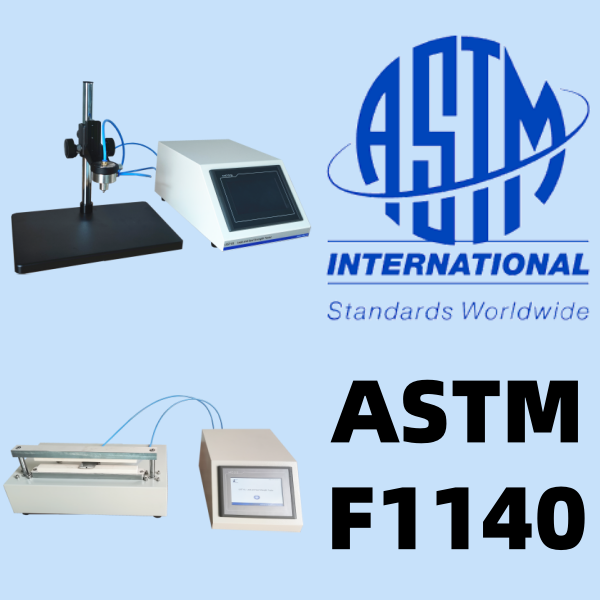АСТМ Ф1140
Package Burst Test Standard
Flexible packaging plays a vital role in the safe distribution of medical, pharmaceutical, and consumer products. Ensuring its reliability during processes like sterilization and transport is critical. That’s where АСТМ Ф1140 comes in—a widely accepted burst test standard that evaluates package integrity under internal pressurization.
Understanding ASTM F1140 and Its Importance
АСТМ Ф1140 outlines test methods that simulate real-world pressure conditions to determine the failure resistance of unrestrained flexible packages. This standard helps manufacturers comply with regulatory requirements and supports continuous quality improvement.
Test Methods Under ASTM F1140
ASTM F1140 includes three core test procedures to assess different package failure characteristics:
Burst Test (Test Method A)
In this package burst testing method, internal pressure is gradually increased until the package ruptures. This directly measures the maximum pressure the package can withstand before failure, indicating its burst strength.
- Applications: Ideal for quality control during production and post-sterilization package evaluation.
- Процедура: A package—sealed or open—is placed in a specialized tester. Pressurization begins and continues until visible rupture or seal failure occurs. The point of failure and pressure value are recorded.
- Equipment: Requires precise pneumatic control, real-time pressure monitoring, and an accurate pressure regulator.
Creep Test (Test Method B1)
This method tests the package’s ability to maintain a specified internal pressure over time.
- Applications: Best suited for materials that may fail over prolonged exposure to pressure.
- Процедура: The package is inflated to a preset pressure (typically 80% of its burst strength) and held for a designated time—usually 15 to 30 seconds. Observers watch for deformation or seal yielding.
- Result: Pass/fail based on whether the package sustains the pressure without failure.
Creep to Failure (Test Method B2)
An extension of the Creep Test, this version maintains a high internal pressure (usually 90% of burst strength) until the package ultimately fails.
- Test statistic: Time until failure.
- Purpose: Measures long-term pressure durability and resistance to gradual failure.
ASTM F1140 in Packaging and Quality Control
Understanding the significance of ASTM F1140 helps packaging engineers and quality professionals:
- Simulate real-world pressure variations during transport and sterilization.
- Evaluate material or seal weaknesses across package types.
- Compare performance across materials or manufacturing lots.
- Ensure positive pressure leak test performance for sterile packaging.
Each method provides unique insight into how well a package can withstand internal pressure. Together, they form a robust framework for flexible package validation.
ASTM F1140 Equipment Requirements
To meet the requirements of ASTM F1140, the testing system must allow:
- Controlled and measurable internal pressurization.
- Quick response time for pressure drop detection.
- Support for open and closed package testing.
Adjustable test configurations (pressure rate, time, entry points).
Cell Instruments offers a solution that checks all these boxes.
Best Practices for Accurate Burst Test Results
To ensure the validity of your ASTM F1140 tests, follow these recommendations:
- Condition samples per ASTM standards (e.g., ASTM E171) to standardize temperature and humidity.
- Avoid restraining the package during testing—keep it in an unrestrained condition.
- For closed packages, insert the pressure entry device at the center and reinforce with tape if necessary.
- Use consistent pressure ramp rates to avoid skewed results.
- Always document the package’s configuration, failure mode, pressure reading, and any anomalies.
Примене у различитим индустријама
АСТМ Ф1140 is applicable to various sectors:
- Medical device packaging: Ensuring sterile barrier system integrity.
- Pharmaceutical packaging: Verifying sealed pouch durability after sterilization.
- Food and beverage pouches: Testing burst resistance for high-pressure processing.
- Consumer goods: Validating flexible film packaging used in household products.
LSST-01 Pouch Burst Tester by Cell Instruments
For manufacturers seeking precise, reliable, and easy-to-use equipment, the ЛССТ-01 Тестер пуцања врећице from Cell Instruments is an ideal choice. It supports:
- Burst testing, creep, и creep-to-failure modes in full compliance with АСТМ Ф1140.
- И једно и друго open and closed package configurations.
- Accurate pressure control, digital monitoring, and automatic recording of test parameters.
With an intuitive interface and robust construction, LSST-01 improves efficiency in R&D and quality assurance labs across industries like medical devices, pharmaceuticals, and flexible packaging.
Contact Us Get Rub Testing Solution
For anyone working in flexible packaging quality control, АСТМ Ф1140 provides a scientifically sound approach to evaluating the strength and durability of packages under internal pressure. Implementing ASTM F1140 testing with trusted equipment like Cell Instruments’ LSST-01 Pouch Burst Tester enhances your quality assurance process and supports continuous improvement.
ФАКс
ASTM F1140 evaluates the resistance of unrestrained packages to internal pressurization until failure.
Burst tests apply increasing pressure until failure, while creep tests maintain a steady pressure over time to observe resistance.
It is primarily used for flexible packaging. Rigid containers require different test methods.
Yes. Testing can be conducted with or without product contents, but the configuration should be documented.



